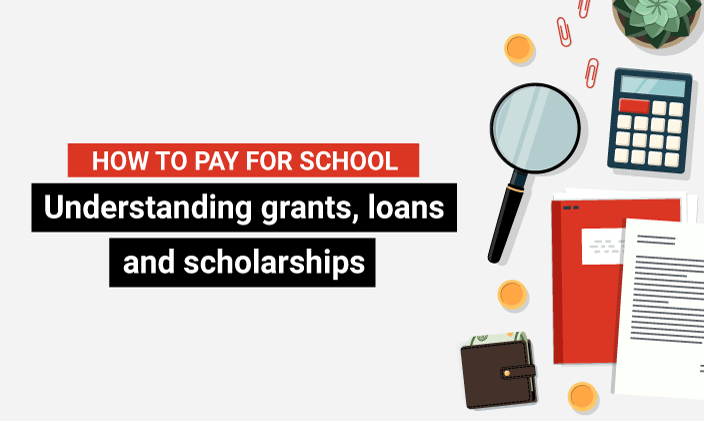Secrets of scholarships: Your step-by-step guide to an effective essay

By Elizabeth Exline
Whether contemplating a return to college or graduate school, there are plenty of factors to consider. Where to go, what to major in and how to juggle your studies with everything else in your life — it’s a lot. But the real elephant in the room is the question of payment, and scholarships can be the proverbial Band-Aid® that makes the whole process better.
“Ultimately, it lifts the burden,” says University of Phoenix (UOPX) alumnus Dexter Peggins Jr. “Scholarships let students be the best students they can be because they are relieved of that financial burden.”
Peggins speaks from experience. He earned his Public Administration online master's in 2017 largely thanks to the AMVETS scholarship he received through UOPX. Today, he works as a leadership coach, author and speaker with Kingdom Solutions Consulting and says his master’s degree is part of his bigger plan to pursue a career in politics.
But earning a scholarship can be easier said than done. Where do you find one? How do you nail the essay part? What strategy should you employ to make sure you earn enough to pay for as much of your degree as possible? Here’s what you need to know.
How to find the right (scholarship) fit
When Peggins was considering graduate school, a scholarship was a necessary part of the equation. His family budget didn’t allow for a lot of “wiggle room,” he says, and he’d already bowed out of a different master’s program when a scholarship only got him through two semesters. The military-related scholarship he earned later, however, empowered him to start and finish his degree at UOPX.
“I knew they were only giving out two [of those] scholarships at that time. So, I was fortunate enough to be one of the recipients,” Peggins recalls.

Peggins’ first scholarship experience is not unusual. Finding a scholarship can feel like winning the lottery (free money to go to school!) until it runs out or you realize that it won’t cover everything. It is for this reason that Krystal Christopher, a senior finance advisor with UOPX, prefers a different analogy. She likens the scholarship search to a second job — you have to commit the time, energy and organization to the process if you’re going to be successful.
The good news? Finding scholarships is easier than ever. Here’s how Christopher recommends approaching the process:
Stay calm and search on
You can have too much of a good thing, even scholarship options. So, as Christopher says, “start small and branch out, because if you look at it from the broader picture, you’ll freak yourself out.”
Reach out to family and friends
This is one of those avenues that can yield unexpected results, Christopher says. Remember that family friend who owns her own business? Her company may offer a scholarship. Your network, your past network, your extended family — everyone is a resource who might either offer or know of someone who offers a scholarship.
“You never know who they know,” Christopher explains. “They might link you up with the right person or the right company that has scholarships.”
Also, Christopher advises checking with your employer to see if it offers either scholarships or tuition reimbursement, both of which are ways to finance college that don’t require payback.
Power up the internet
“Back in the day, I had books,” Christopher says. “I went to Borders, got a cup of coffee and a ton of books [about scholarships]. … Nowadays you’ve got the search engines that will do half the searching for you.”
Christopher’s top picks for scholarship searches?
Leverage your experience
One advantage that adult students enjoy is a greater breadth of experience. Whether it’s philanthropic work, a side hustle in photography or simply a religious, ethnic or cultural affiliation, your interests and experiences can open doors to various scholarships.
“One of the things that was very helpful for me was finding a scholarship that [spoke to my military] experiences,” Peggins says.
So, get back online to see if your interests or experience qualify you for a scholarship opportunity.
Aim high
In addition to searching at the state and national level (after exhausting local opportunities), reach out to your chosen school to see if it or affiliated organizations offer scholarships that might work for you. Big-name companies sometimes work with universities to offer scholarship money to prospective students, and universities themselves offer a range of scholarships as well.
5 steps to earning a scholarship
For the cynics out there, Susan Kalter, MEd, is proof that real people can receive big-name scholarships. Kalter decided to go back to school for her master’s degree after being a stay-at-home mom but, like Peggins, that decision was predicated on receiving a scholarship.
“After you have children, it becomes about them,” she explains, noting that she needed to focus on saving for their educational future rather than spending on her own.
Kalter applied to a few scholarships she found online, but when she came across the Teaming Up For Education® Scholarship (which was available until 2018), she knew she’d found the right one. Sponsored by both UOPX and the Arizona Diamondbacks, the scholarship spoke to Kalter’s love of baseball.
Neither Peggins nor Kalter worried much about the essay portion of the scholarship application. In fact, Kalter, who’d been an English major during her undergraduate career, found the essay portion to be the easiest part of the scholarship application.
The hardest part for her was not “rambling on,” but that’s not usually the case for everyone. So, how do you approach writing an excellent essay when writing isn’t your first love? It all comes down to precision and authenticity.

As in life, details matter in scholarship applications. First, Christopher advises setting manageable filters on your search criteria for scholarships and tracking the ones for which you’ve already applied. There’s nothing quite like investing half an hour in filling out a scholarship application only to realize you applied for the same one three months ago.
So that you can see at a glance what needs doing, Christopher advises maintaining a spreadsheet with details about which scholarships you’ve applied to and when. Also consider receiving alerts just twice a week (rather than daily) so that you don’t get overwhelmed.
When you do find a potential scholarship lead, make sure it’s eligible for use at the school or type of school you want to attend. (Some scholarships, for example, are not applicable at for-profit institutions.)
Once you have the green light on all that, it’s time to read the directions. Carefully. Not following the directions, Christopher says, “happens a lot” and can cause your application to be dismissed.
This applies to the essay as well. Generally speaking, essays are an opportunity to tell a story within a well-defined set of parameters. It’s not a stream-of-consciousness free-for-all.
“Everybody’s got problems. Everybody’s got an experience. However, make sure to answer the question before going into the backstory,” Christopher advises.

While Christopher recommends dedicating a few days a week to the scholarship process — both to review opportunities and apply for them — she also endorses applying for as many as you’re eligible for.
“The more applications you have out, the better,” she says. “Do not look at the amount as such a big deal. It could be something as small as $500. Still go for it if it’s within your category.”
After all, the more scholarships you get, the fewer loans or aid you’ll require. Although the search for scholarships can feel like a second job, it’s a second job that directly benefits you.
“It’s a job for growth, and so it’s [worthy] of your time. It’s about you. This is for you,” Christopher says.

Not every scholarship requires an essay. Others, like the one for which Peggins applied, require more than one. When facing down a slew of essay requests, the most important piece of advice (beyond following instructions) is to be authentic. Don’t exaggerate the circumstances or write what you think someone wants to read.
This was Kalter’s approach when she applied for the Teaming Up For Education Scholarship. “I’m such a sap when it comes to writing,” she says with a laugh. “I was getting weepy with my own writing!”
But she stuck with her gut feeling on what she wanted to say, and it worked.
“Write with honesty and integrity and from your heart,” Kalter advises. “Look at what moves you and worry about the mechanics [of spelling and grammar] later.”

Of course, not every essay will be a home run (pun intended). That’s OK. Take silence to mean rejection and move on. You can still use a good essay for another scholarship as long as you revise it as necessary.
“There’s nothing wrong with that,” Christopher explains. “It will speed up the process, but I do feel like, just as with a resumé, you need to tweak it according to what you’re applying for.”

The highs of earning a scholarship are enough to keep most people in the game, which includes a fair amount of rejection.
As Peggins notes, “If you don’t get the first scholarship you applied for, there are other scholarships out there that might be just right for you.”
It’s important to be strategic and stay optimistic, he says. And, as Christopher notes, scholarships are available for a range of interests and backgrounds: for minorities, for military vets, for single moms — for pretty much everyone.
“If it’s really what you want, then you can find it,” Christopher says. “Money is out there.”
Wondering if you can afford college with or without scholarships? Check out our step-by-step guide to figuring it out.
Scholarships of any amount can help. Learn more about scholarship opportunities at University of Phoenix!
Teaming Up For Education is a registered trademark of University of Phoenix, Inc.
Band-Aid® Brand Adhesive Bandages is a registered trademark of Johnson and Johnson Inc.
Arizona Diamondbacks SM Foundation is a registered trademark of AZPB Limited Partnership a Delaware limited partnership consisting of AZPBI, Inc., its General Partner LIMITED PARTNERSHIP DELAWARE Chase Field, 401 East Jefferson Street Phoenix ARIZONA 85004




